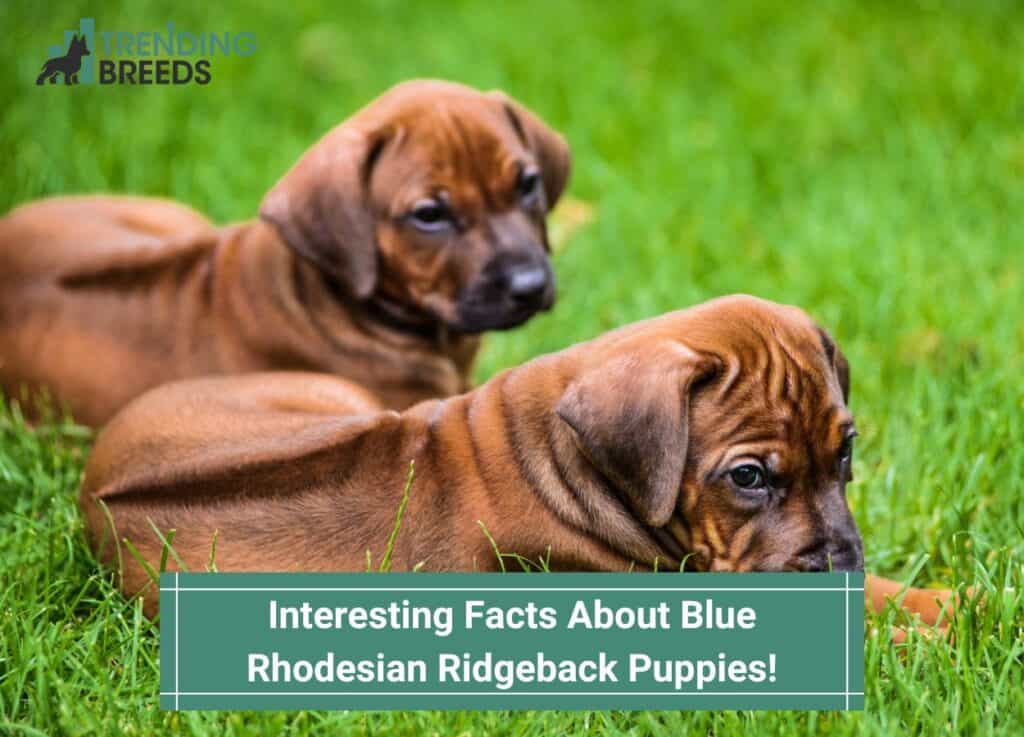
Today we are going to talk about the most interesting facts about Blue Rhodesian Ridgeback puppies. Rhodesian Ridgebacks are one of the world’s oldest dog breeds. As its name suggests, the Ridgeback has an iconic ridge of backward-growing hair.
The breed originated in Rhodesia, now Zimbabwe, and was brought over to Europe during the 19th century.
The breed was unknown in the United States until after World War II. Rhodesian Ridgebacks are now known the world over to be devoted household dogs.
The Rhodesian Ridgeback is the 54th most popular breed, according to the American Kennel Club. They are primarily found in Botswana, Mozambique, Namibia, South Africa, and Zambia.
This versatile breed can hunt, defend, keep an eye on their loved ones, and lavish them with affection.
Their height and power may appeal to owners seeking an athletic and tough-looking dog, yet they are kind and compassionate enough to make them the ideal companion for a household with children.
The Rhodesian is an affectionate, brave, and intelligent breed, but he can also be stubborn sometimes. The accepted color of the Rhodesian Ridgeback is wheaten, however, some Ridgebacks have been known to have blue coats.
A blue dog isn’t actually blue but more a gray or silvery color, with a bluish nose. Some Ridgebacks also have blue eyes!
In this blog post, we’ll look more closely at the Rhodesian Ridgeback and learn more about this fascinating breed.
Other articles you would like: Rhodesian Ridgeback Puppies In California and Rhodesian Ridgebacks: The Good And The Bad
Table of Contents
Rhodesian Ridgeback History
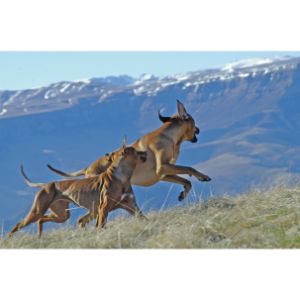
The Rhodesian Ridgeback breed’s origins may be traced back to semi-wild canines native to southern Africa, bred with other breeds imported to the region by European immigrants in the 1600s.
The Cuban Bloodhound, an extinct breed used for dogfighting and watchdog, was heavily influenced by the early Rhodesian Ridgeback.
Genetic study shows that the Rhodesian Ridgeback and the Great Dane have the same genetic clade, implying that Danes contributed significantly to today’s Ridgeback dogs.
These Dane breeds were crossed with indigenous African dogs, particularly the Khoikhoi dog, resulting in the Boer hunting dogs, the forerunners of the contemporary Rhodesian Ridgeback.
According to ancient dog genome sequencing, the southern African Rhodesian Ridgeback has a 4% pre-colonial heritage.
Ridgebacks were bred in Africa to corner and restrain large game prey, such as lions and bears.
They became so prevalent for holding game prey for a long time when hunting lions that they started to be commonly called Lion dogs back in the day.
However, many people misunderstood this name to mean that these dogs were able to kill lions, but it was far from the truth. In combat with a lion, no dog would have had a chance.
The Ridgebacks would instead hassle the lion with frequent feint assaults until it was distracted, allowing the hunter a close-range shot.
With the introduction of long-range weapons, hunters no longer needed dogs, so the Ridgeback had to adapt to its new role as a guard dog.
Even now, some Rhodesian Ridgebacks can aim and retrieve. The breed is continued to be one of the choices for help in hunting.
The Rhodesian Ridgeback can also compete in various dog sports, including agility, and would make a great hiking and jogging companion.
Characteristics
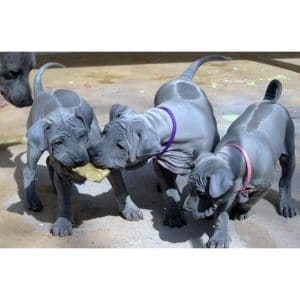
Powerful and agile, these are gentle, affectionate, and caring dogs that can sometimes be also determined and stubborn. They are independent but are also very affectionate and loyal toward their friends and family.
They are calm and easy-going, putting up with endless torment from children. They are always delighted in their human family activities, but at the same time, they are also content to laze around all day.
The Ridgeback is an excellent guard dog with a deep bark to warn intruders to keep away.
Rhodesians rarely show any aggression toward humans. They are also generally compatible with other dogs, mainly when they have been part of the same environment from an early age.
Nevertheless, they have a reputation for rising to a challenge and defending themselves in a doggie quarrel, especially with dogs of the same gender.
Appearance
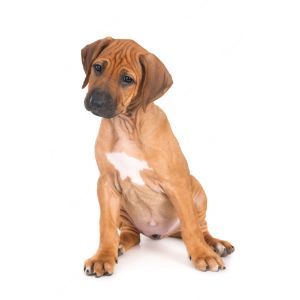
Rhodesian Ridgebacks are medium-sized dogs with muscular bodies and short coats. They are powerful dogs with a body that is symmetrical and well-balanced.
The breed’s striking feature is a ridge of hair that grows along the spine from the shoulders to the hip bones in the opposite direction from the rest of the coat. Their back is firm and is supported by muscular legs with well-arched toes.
They have expressive round eyes in brown or amber sparkle, while the medium-sized ears are wide at the base, tapering at the point, and are set high up the head. They carry their tail slightly curved up.
Their coat is made to survive in hot climates and consists of short, dense hair that is glossy looking. The colors range from red to brown wheaten, with white patterns on the chest and toes.
While the more traditional color is wheaten, some Ridgebacks have been known to have blue coats and blue eyes.
Grooming Requirements
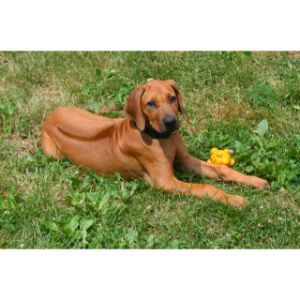
Rhodesian Ridgebacks are a low-maintenance breed because of their short, glossy coats. All they need is a weekly brushing of their hair and maybe a wipe-over with chamois leather every couple of hours.
They shed throughout the year, but it is more observed during the fall season, and more frequent brushing of hair may be required to get rid of all the loose hair and dead cells from your pooch’s coat.
Activity Levels
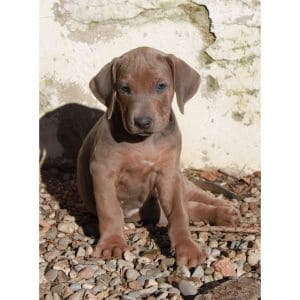
They need daily physical activity and mental stimulation to keep them happy and healthy because a bored Rhodesian Ridgeback is a destructive dog.
Give a Ridgeback at least an hour of activity every day in the form of brisk walks, jogs, hiking, a game of fetch, and a chance to run in a safely enclosed area twice a week, and he’ll be happy — at least in terms of physical exercise.
This breed is also excellent in dog sports like agility, obedience, and lure coursing. Engaging them in dog sports is also a good way for your dog to exercise and challenge its mind.
With the appropriate training, Rhodesian Ridgebacks may be calm and friendly dogs who enjoy being part of the family.
Health and Lifespan
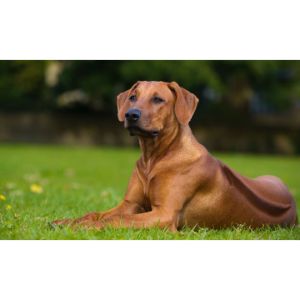
The average lifespan of 10 to 12 years for Rhodesian RidgebackRidgeback is slightly on the lower side compared to most other medium-sized dogs.
Just like other dog breeds, Rhodesian RidgebackRidgeback is also prone to some hereditary diseases such as :
Hip dysplasia
Hip dysplasia is a common condition in dogs that can cause pain and lameness.
The condition occurs when the hip joint does not develop properly, causing the joint to be loose and unstable. This can lead to wear and tear on the joint, resulting in pain and inflammation.
In severe cases, hip dysplasia can lead to arthritis and even crippling. The best way to prevent hip dysplasia is through responsible breeding practices.
Although hip dysplasia can’t be cured, there are treatments available that can help to relieve pain and improve mobility.
Elbow dysplasia
Elbow dysplasia is a common condition in dogs that can cause pain and lameness. The condition is caused by a malformation of the elbow joint, which can lead to the development of arthritis.
Elbow dysplasia is most commonly seen in large breed dogs, though it can affect any size or type of dog.
Symptoms of elbow dysplasia include limping, reluctance to move, and pain when the joint is touched. If left untreated, elbow dysplasia can cause significant joint damage and mobility problems.
Treatment for elbow dysplasia typically involves weight management, exercise modification, and medication. In severe cases, surgery may be necessary to repair the joint damage.
Canine epilepsy
Canine epilepsy is a neurological disorder that affects dogs of all breeds and sizes.
The most common symptom of epilepsy is seizures, which can range from mild to severe. In some cases, seizures may only occur sporadically, while in others they may occur daily.
Epilepsy is typically diagnosed based on a combination of clinical signs and medical testing, though in some cases the cause of the seizures may never be determined.
There is no cure for epilepsy, but many dogs can lead normal, happy lives with the help of medication or dietary changes.
Dermoid Sinus
Dermoid sinus is a congenital malformation that is seen occasionally in certain breeds of dogs.
It consists of a tract that connects the surface of the skin to a deep level within the tissue. The tract may be lined with the epidermis, hair follicles, or sebaceous glands.
Dermoid sinus is thought to arise during embryonic development when the neural tube fails to close properly.
The condition is usually diagnosed at birth or during puppyhood when the sinus tract becomes apparent as a raised line or depression on the surface of the skin.
Treatment involves surgical excision of the dermoid sinus tract. In most cases, this can be performed successfully with no recurrence.
However, dermoid sinus can sometimes be associated with other congenital abnormalities, so puppies should be examined thoroughly by a veterinarian before purchase to ensure that they are healthy and have no hidden health problems.
Hypothyroidism
Hypothyroidism is a condition that can affect dogs of any age, breed, or gender. It occurs when the thyroid gland doesn’t produce enough hormones, which can lead to several health problems.
Symptoms of hypothyroidism include weight gain, hair loss, lethargy, and chronic skin problems. If left untreated, hypothyroidism can cause heart disease, neurological problems, and even death.
Although there is no cure for hypothyroidism, it can be managed with medication.
Pros and Cons of The Rhodesian Ridgeback
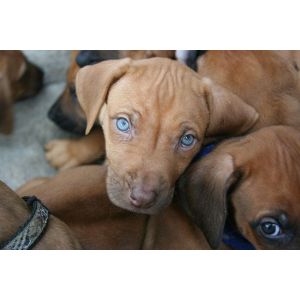
Pros
- Rhodesian Ridgebacks are very loyal and affectionate
- They are one of the best guard dogs in the hound group
- They are gentle around the house and make great family pets
- They must engage in strenuous daily activity. and offer plenty of options for those who lead active lives
- They are intelligent and easy to train with the right hand
- They have minimal fur
Cons
- Ridgeback puppies are very boisterous and mature rather slowly
- They are more suited to households with older children
- They need a lot of mental stimulation and daily exercise
- Puppies need good socialization from an early age
- Ridgebacks are highly territorial and protective
- They have a high prey drive
- They are strong-willed, which makes training more challenging
- They are not the best choice for first-time dog owners
- Ridgebacks have a low boredom threshold
Is The Rhodesian Ridgeback The Right Breed For You?
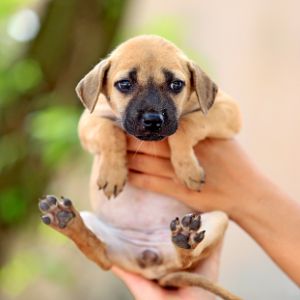
Although they are friendly and confident at home, they are very wary of strangers both humans and canines.
In addition, their stubborn nature coupled with their size and strength makes the need for experienced handling and training, together with early, thorough and ongoing socialization.
They are not the ideal breed for the novice owner and they need experienced dog owners with the time and resources to invest in their training.
Conclusion For “Interesting Facts About Blue Rhodesian Ridgeback Puppies”
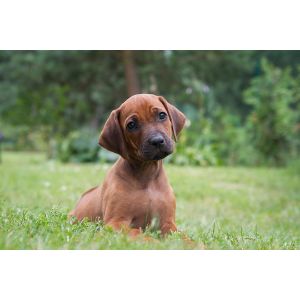
Blue Rhodesian Ridgeback puppies are a rarity. The accepted color by the American Kennel Club of the breed is only wheaten, but you might get lucky and find one with a blue coat.
Whatever the color, this incredible breed whose claim to fame is hunting lions will make an excellent addition to experienced, active households!
You will also like:
- Are Rhodesian Ridgebacks Good House Dogs?
- Are Rhodesian Ridgebacks Dangerous?
- Interesting Facts About The Black Cane Corso
For more information about the Rhodesian Ridgeback Breed, check out the video below:




